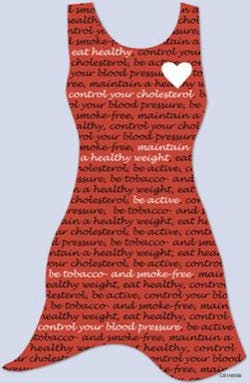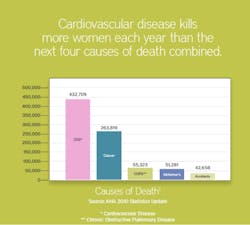Heart disease affects and manifests itself differently in women and men. Coronary heart disease (CHD), which includes myocardial infarction (MI; heart attack) and angina pectoris (AP), stroke, congestive heart failure (CHF), and cardiac arrest are types of cardiovascular disease (CVD). CVD affects 25% of American women and men, and is the leading killer in America.(1) However, it is often viewed as a “man’s disease.”(2) Since 1984, more women than men have died of CVD every year.(3) In 2002, CVD killed 493,623 women compared with 433,825 men. Fifty-three percent of CVD deaths occur in women.(3)Women characteristically develop clinically evident CHD up to 10 years later than men. (1) According to the Framingham Heart Study (FHS), the lifetime risk of developing CHD after age 40 is 49% and 32% in men and women, respectively.(1) While CHD deaths have decreased in men, studies indicate that CHD deaths in women have remained stable or even have increased.(4) After menopause, the rate of CHD is 2-3 times that of premenopausal women who are the same age.(3) Cardiac arrest is about three times greater in men than in women, However, women have lower recovery and survival rates than men.(5) Studies have shown that low levels of HDL convey a higher risk for CVD in women.(3,6) Women’s total cholesterol is higher than men’s cholesterol beginning at age 45.(3) As women go through menopause, their lipid profiles change and become more atherogenic.(4) High triglycerides may increase the risk of CVD for women more than for men.(7)
There is a Go Red Heart CheckUp. Take the Go Red Heart CheckUp today to learn your risk. It’s free, only takes a few minutes and could save your life.(8) Evidence-Based Guidelines for the Prevention of Cardiovascular Disease in Women are available.(9) They include Lifestyle Interventions, Major Risk Factor Interventions, Preventive Drug Interventions, and an Explanation of Recommendation Classifications.
Matters of the Heart: Second Annual Women's Heart Conference, presented by University of Minnesota Physicians Heart in cooperation with WomenHeart: The National Coalition for Women with Heart Disease and the American Heart Association, will be held February 17, 2012, The Westin Hotel Galleria, Edina, MN, for healthcare professionals.(14)References
1. Heart disease and stroke statistics-2005 Update. 2004. Dallas, TX American Heart Association www.americanheart.org. 2. Women, heart disease and stroke. American Heart Association www.americanheart.org.3. Women and cardiovascular diseases-Statistics. 2004 American Heart Association www.americanheart.org. 4. Mieres, J.H., et al., Role of noninvasive testing in the clinical evaluation of women with suspected coronary artery disease: consensus statement from the Cardiac Imaging Committee, Council on Clinical Cardiology, and the Cardiovascular Imaging and Intervention Committee, Council on Cardiovascular Radiology and Intervention, American Heart Association. Circulation, 2005. 111(5): p. 682-96. 5. Kim, C., et al., Out-of-hospital cardiac arrest in men and women. Circulation, 2001, 104 (22): p. 2699-703.6. Polk, D.M. and T.Z. Naqvi, Cardiovascular disease in women: sex differences in presentation, risk factors, and evaluation. Curr Cardiol Rep, 2005. 7(3): p. 166-72.7. The Health Consequences of Smoking: A Report of the Surgeon General. 2004. Department of Health and Human Services.8. www.goredforwomen.org/hcu/index.aspx. 9. www.goredforwomen.org/Professionals/.10. www.goredforwomen.org/understand_your_risks.aspx.11. www.cdc.gov/women/heart/.12. www.womenheart.org/. 13. www.womenheart.org/documents/upload/10Q-FINAL-REVISED-6-28-11.pdf. 14. www.umphysicians.org/womensheartconf/.
Maria Perno Goldie, RDH, MS
To read previous articles in RDH eVillage FOCUS written by Maria Perno Goldie, go to articles.












